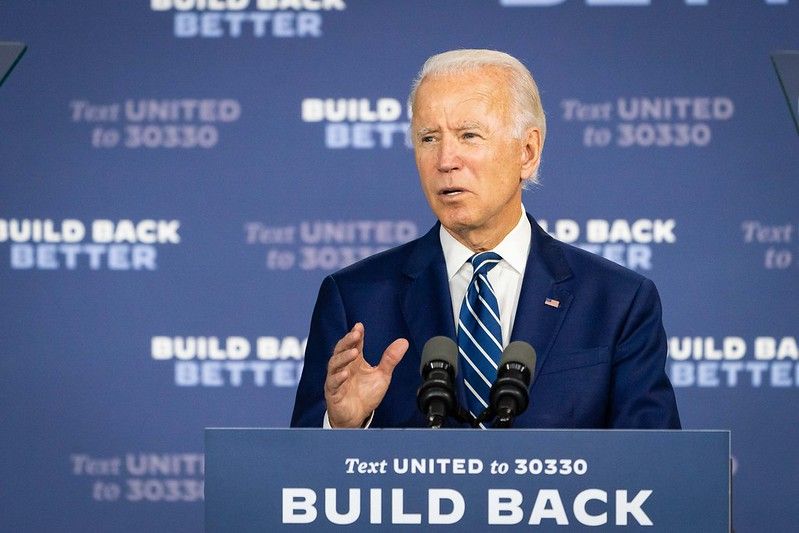Is it a concerning sign of what's ahead?
I’m Isaac Saul, and this is Tangle: an independent, ad-free, subscriber-supported politics newsletter that summarizes the best arguments from across the political spectrum — then “my take.” You can read Tangle for free or subscribe for Friday editions, and you can reach me anytime by replying to this email. If someone sent you this email, they’re asking you to sign up. You can do that by clicking here.
Today’s read: 10 minutes.
The jobs report. Plus, a reader asks about my favorite politician.

Hello from somewhere.
I’m out in the desert this week. Thank you to all the subscribers who sent in recommendations over the weekend. Here are a few photos from the border in West Texas, where I spent the last few days. Next up: Colorado, then New Mexico.
I came down this way to surprise my cousin for his 50th birthday party. Another cousin who showed up for the party tried to dress like him, and I’d say just about nailed it (the “real” Lico is on the right, the fake Lico on the left):



Quick hits.
- A series of mass shootings rocked the United States again this weekend. Six people were killed in a Colorado Springs shooting (Colorado Springs Gazette), three were hurt in a Times Square shooting (The New York Times), three more were hurt in a mall shooting in Miami (Miami Herald), and four were killed in a shooting in Baltimore (Baltimore Sun).
- The supply of coronavirus vaccines is beginning to outstrip demand in several states, as the pandemic and push to vaccinate Americans enters a new phase. (The New York Times, subscription)
- Democratic and Republican staffers in Congress are drafting language for possible police-overhaul legislation that would limit the transfer of some military equipment to local departments, ban police use of chokeholds except in life-threatening situations, and set federal standards for so-called no-knock warrants. (The Wall Street Journal, subscription)
- Republican House leader Rep. Kevin McCarthy (R-CA) said he supports replacing Rep. Liz Cheney (R-WY) as conference chair. (The Washington Post, subscription)
- 228 Palestinians are reportedly in the hospital after a clash with Israeli police that occurred in a Jerusalem holy site on Monday. Police said 21 officers were hurt. (Associated Press)
What D.C. is talking about.
The latest jobs report. On Friday, the U.S. government reported unexpectedly slow job growth for last month, with just 266,000 new nonfarm payroll jobs. Unemployment also ticked up by 0.1, to 6.1 percent. Economists had predicted just short of one million jobs being added, representing one of the biggest forecasting misses in decades. Additionally, March’s jobs report was revised downward to 770,000 jobs added instead of the 916,000 reported previously.
The Labor Department’s report showed a major drop in temporary help jobs and decreases in manufacturing, retail and courier services employment, according to Reuters.
President Biden reacted to the report on Friday. “Today's report just underscores in my view how vital the actions we're taking are,” he said. “You might think that we should be disappointed, but when we passed the American Rescue Plan, I want to remind everybody, it was designed to help us over the course of a year -- not 60 days, a year… We never thought that after the first 50 or 60 days, everything would be fine."
Economists had mixed reactions to the report, with some blaming the shortfall on generous unemployment benefits and others saying the issue was how many parents are unable to go back to work because their children are still learning remotely.
Below, we’ll take a look at some reactions to the report.
What the right is saying.
The right has said Biden’s economic policies are slowing growth, and the new report is proof that enhanced unemployment benefits are keeping people from going back to work.
The Wall Street Journal editorial board said “the Keynesians who now run U.S. policy, at the Treasury and Federal Reserve, have been using their usual demand-side playbook. Bathe the country in government cash, keep interest rates at zero, and the resulting rise in consumer demand will drive everything.
“They’ve underestimated the supply-chain constraints that have been screaming across the economy for months—from too few workers to the computer chip shortage and soaring lumber and freight prices,” they wrote. “The economy can’t produce enough goods and services fast enough to meet the soaring demand from the easing pandemic and government policies that have shoveled cash to consumers and rewarded Americans for not working.
“Employers across the country have been complaining for months that the federal $300 weekly jobless bonus has made it difficult to hire. Most lower-income workers can make more sitting on the couch. It’s notable that half of the new labor market entrants last month were teens, most of whom don’t qualify for jobless benefits because of their short or nonexistent employment histories. This was all predicted a year ago by these columns and a few others, including Sens. Ben Sasse and Lindsey Graham and economists Casey Mulligan and Steve Moore. But even as the economy was growing fast again, Democrats in March extended the $300 weekly bonus into September even as they ladled out a bonanza of other transfer payments.”
In The Washington Post, Kathleen Parker said finding people to work as jobs reappear “has become daunting if not impossible, particularly at the lower end of the pay scale.”
“Ask almost any employer and you’ll hear the same: There are plenty of jobs but filling them is another matter,” she wrote. “In South Carolina, where tourism matters and the hospitality industry has been hardest hit, 80,000 jobs are currently available, according to the governor’s office. Restaurants can’t stay open without servers and other staff who, thanks to the extra stimulus money, don’t see the point of working. The same goes for hotels and other establishments…
“Some of the reasoning behind continuing stimulus and other supplemental funds, meanwhile, is pinned to people’s understanding of covid-related health risks,” she added. “While conservatives have tended to play down the risks of infection — often to the point of absurdity — liberals are slow to let go of the dangers despite the rise in vaccinations and scientific evidence that it’s safe to go and play outside. Today, roughly half of all American adults have received at least one shot of a vaccine… Economic incentive is what drives human beings. What began as a helping hand now looks like an incentive to take a nap. For the economy’s sake, let’s get vaccinated and back to work.”
The National Review editors said with wider vaccination and more businesses reopening, we are in a much different place today.
“A report from the National Federation of Independent Businesses found that a record 42 percent of business owners had job openings that could not be filled,” they wrote. “The Bureau of Labor Statistics recorded 7.4 million job openings at the end of February. And data in its Friday jobs report showed a noticeable spike in hours worked, which also suggests that currently employed workers have had to take on more hours because it’s been hard to hire.
“Even former Obama administration economic advisor Jason Furman, now at Harvard, told CNBC, ‘If you look at April, it appears that there were about 1.1 unemployed workers for every job opening. So there are a lot of jobs out there.’”
What the left is saying.
The left has argued that a single jobs report can be misleading, and that there is more nuance to the numbers than disincentives to work due to higher than usual unemployment benefits.
Paul Waldman said that in “ordinary times, a monthly report showing the American economy added 266,000 jobs would be great news.”
“The liberal argument is that a restaurant owner having trouble hiring workers for $2.13 an hour plus tips should offer a higher wage; that’s how supply and demand works,” he wrote. “As Paul Krugman says, ‘Employers competing for workers by raising wages isn’t a problem, it’s what we want to see.’ Republicans, on the other hand, want to tell a story in which this is an unfolding tragedy created by giving stimulus checks and unemployment benefits to lazy moochers who now refuse to work.”
“It’s awfully rich to hear these arguments coming from Republicans, who are so committed to making work as miserable and unremunerative as possible,” he wrote.
”They fight against raising the minimum wage, against paid family leave, against collective bargaining, against worker safety regulations, against providing child care, and against universal health coverage, then ask why every last unemployed person isn’t rushing back to take any work they can find.”
In Business Insider, Anthony Fisher said that “for millions of Americans, there's a simple reason they're not working. It's the closed schools, stupid.”
“Fake ‘open’ schools Occam's Razor, in layman's terms, is the principle which holds that the simplest explanation is probably the correct one,” he said. “The reason so many working parents — especially women — haven't returned to the job market is because there is nowhere for their kids to go during the day. Unaffordable or unavailable childcare is always an issue in this country, which does very little to make life more bearable for new parents.”
In Vox, Emily Stewart said: “It’s hard to argue that the Bureau of Labor Statistics’ April jobs report was good — not to mention that the jobs numbers from March were revised down as well, meaning the economy actually added fewer jobs that month than initially reported.
“But it also reinforces something that’s been true throughout the pandemic: A lot of what’s going on in the economy is just going to be completely unpredictable. Plenty of people would not have expected a housing boom, a chicken wing shortage, or a run on lumber, either...
“The biggest gains in April were in the leisure and hospitality industries, which makes sense, given how hard the sector was hit when economies closed down and the fact that vaccinated people are starting to feel more comfortable going on vacation and out to eat. But there were other developments that were more puzzling or, at the very least, don’t have a sure explanation.
“For instance, employment in construction didn’t change, even though construction season is sort of upon us,” she said. “Employment in temporary help services (temp jobs) and couriers and messengers fell. On temp job declines, you could take it as a good sign that companies were perhaps hiring workers full time, but it’s not guaranteed that’s what happened. With courier and messenger jobs, a possible explanation could be that people are ordering less delivery as they go back to restaurants, for example. But again, that’s just a possibility.
“There’s often not a linear story when it comes to what’s going on in the economy, and there likely isn’t one in this case,” Stewart concluded. “A variety of explanations for what happened in April could all be true. But because we live in such a politically charged environment, people tend to be selective in the narratives they embrace that align with their own interests and beliefs.”
My take.
This is one of those weeks where it seems as if even the economists don’t understand the economy — or, at the very least, they can’t predict what’s coming with much confidence.
I’d be lying if I told you I felt confident gleaning any insight more valuable than what you get from the columnists and experts above. There are so many factors at play in a jobs report during normal times, but accurately assessing a jobs report after millions of job losses and trillions of dollars in aid due to a year-long global pandemic adds a few more layers of complexity.
Anecdotally, I’ve seen evidence the enhanced unemployment benefits function as a work disincentive. Plenty of my friends have conceded that they’re comfortable waiting the pandemic out a bit longer, even if they’re fully vaccinated, because the safety net is actually enough assistance that they won’t go broke without a job. That’s a good thing to me in many respects (i.e. I think many states’ unemployment programs are woefully insufficient), but it also seems obvious it’s playing a role. And if it is, cutting those federal unemployment benefits — given the availability of vaccines and the safety of returning to work in most places — is a reasonable policy solution.
Then again, it’s complicated. The labor force grew by 430,000, an indication that unemployment went up because more people were looking for jobs. Many of the stories about employers struggling to find workers came from the hospitality and leisure industries, which actually had a pretty good month. School reopenings, too, are going to boost economic numbers, because it will allow parents struggling to find child care to get back to work.
In Slate, Jordan Weissmann suggested this could be a blip — and that next month’s jobs report would be needed to see if things are bouncing back or if there is a real need to reassess. I think that’s a fair way to look at this.
But there’s also no doubt it’s concerning. The full picture is that fears of inflation are growing, the jobs boom that economists predicted for this month just fell on its face, and most of what President Biden would be able to easily push through Congress has already passed. This moment certainly calls for some patience, but the folks who feared too much government support would slow the economic recovery couldn’t have asked for a more potent piece of evidence than this jobs report.
Most people do not have a news source they say they can trust. Tangle is trying to be that source — for global citizens on the left, right and center. If you believe in this new generation of political coverage, please consider sharing Tangle.
You can email Tangle to friends by clicking here.
Your questions, answered.
Q: Who is your favorite politician? Why?
— Nolan, Louisville, Kentucky
Tangle: I’ll concede right away that I’m not going to answer that question directly. Of course, like most Americans, I tend to like politicians who get things done and share some or most of my worldview. Given that I have so many competing and even conflicting feelings on so many issues, it’s not particularly easy to find politicians who fit that description for me. But I’ll settle for some who are unique, mostly honest, and bring some qualities to bear that I think move the country in a positive direction.
Rep. Justin Amash, once a Republican and now an independent, has a consistent worldview and has become increasingly outspoken against war and hypocrisy in Congress. Rep. Katie Porter (D-CA) is probably one of the best questioners I’ve ever seen in Congress, and knows how to pin down a bad argument. Mark Gordon (Wyoming) and Larry Hogan (Maryland) are two Republican governors who rightly enjoy fantastic approval ratings because they do largely what their constituents want, work across the aisle, and run functioning state governments. Sen. Tim Scott (R-SC), who I’ve been writing about recently, has a moving life story and seems dedicated to working with folks across the political spectrum on a range of issues.
One of the tough parts of an exercise like this is that politicians are often acting on incentives to obscure, lie, pander, and all the rest. So it’s not always easy to discern what they’re actually getting done or what their motivations are. Do I like Bernie Sanders? I do. I think he genuinely wants to help the working poor and I think his worldviews are remarkably consistent and clear. Those things are good to me. But do I think all his ideas are good? I don’t. And anytime you say you even “like” someone, you immediately put yourself in the position of having to defend everything they do.
All that makes me hesitant to give one specific name here. Still, my general feeling is that if a politician is not openly hypocritical and not making decisions solely in order to keep or acquire more power (rather than to help constituents), then I’m likely to feel positively about them.
Have a question you want to be answered in the newsletter? Simply reply to this email or write in using this form.
A story that matters.
The price of corn has risen 50 percent in 2021, a boom that will have broad implications for American consumers across the country. “Corn is a key ingredient in making goods ranging from tortilla chips and chicken wings to bourbon and Coca-Cola,” The Wall Street Journal reported. “About 40% of the U.S. crop is blended into motor fuel.” That means prices for all those things could go up for consumers across America. At the same time, the rise in cost is benefitting a variety of businesses in the agriculture industry. (Wall Street Journal, subscription)
Numbers.
- 69%. The percentage of Wyomingites who approve of their governor, Mark Gordon, the highest of any governor in America.
- 8 million. The number of jobs below pre-pandemic levels we are after last month’s jobs report.
- 45%. The percentage of fuel in the Eastern United States carried by Colonial Pipeline, which is still struggling to get up and running after a cyber attack on Friday.
- -30%. The drop in COVID-19 cases in the United States over the last two weeks.
- 2 million. The average number of COVID-19 vaccines administered daily in the United States over the last week, slightly down from the weeks before.
Chip in?
Tangle needs your help. Unlike other media outlets, we rely entirely on subscription revenue. Our goal is to keep as much of the newsletter free for as many people as possible, while also being ad-free. But it only works if our readers subscribe when they can. For just $4.16/month, you can get access to Friday editions of Tangle.
Have a nice day.
Pioneers in the 3D printing industry have realized that wood waste could be a great source material. A new start-up is launching called Forust, with a process that can mimic any type of tree (from ash to mahogany, according to Fast Company). With 15 billion trees cut down a year, environmentalists are hopeful that the advent of 3D printing wood can reduce the amount of wood waste. “It’s going into landfill right now,” Ric Fulop, the CEO of the company that owns Forust, said. “Hundreds of millions of metric tons of waste is generated every year just in the U.S. alone.” (Fast Company)


